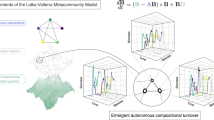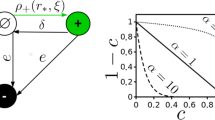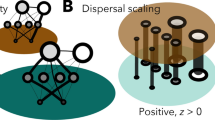Abstract
Metapopulations persist when local populations are rapidly recolonized following local extinctions. Such persistence requires asynchrony; simultaneous crashes of all populations would leave no source of recolonization. We show theoretically and experimentally that catastrophic population extinctions themselves can promote metapopulation persistence, by preventing spatial synchrony and thus enhancing recolonization. We refer to this behaviour as the ‘spatial hydra effect’: as with the mythical hydra that grows two new heads when one is removed, extinctions can increase recolonization. The effect is robust, occurring in a wide range of theoretical models exhibiting cyclic or quasi-cyclic population dynamics. In a laboratory microcosm experiment using cyclic protist predator–prey metapopulations, catastrophic perturbations wiping out populations but leaving the patch otherwise unchanged increased metapopulation persistence when high dispersal rates would otherwise have led to spatially synchronous extinctions of all populations. We discuss several candidate examples of the spatial hydra effect in nature.
This is a preview of subscription content, access via your institution
Access options
Access Nature and 54 other Nature Portfolio journals
Get Nature+, our best-value online-access subscription
$29.99 / 30 days
cancel any time
Subscribe to this journal
Receive 12 digital issues and online access to articles
$119.00 per year
only $9.92 per issue
Buy this article
- Purchase on Springer Link
- Instant access to full article PDF
Prices may be subject to local taxes which are calculated during checkout




Similar content being viewed by others
References
Husband, B. C. & Barrett, S. C. H. Spatial and temporal variation in population size of Eichhornia paniculata in ephemeral habitats: implications for metapopulation dynamics. J. Anim. Ecol. 86, 1021–1031 (1998).
Pajunen, V. I. & Pajunen, I. Long-term dynamics in rock pool Daphnia metapopulations. Ecography 26, 731–738 (2003).
Biedermann, R. Modelling the spatial dynamics and persistence of the leaf beetle Gonioctena olivacea in dynamic habitats. Oikos 107, 645–653 (2004).
Schöps, K. Local and regional dynamics of a specialist herbivore: overexploitation of a patchily distributed host plant. Oecologia 132, 256–263 (2002).
Hanski, I. A. Evo-evolutionary spatial dynamics in the Glanville fritillary butterfly. Proc. Natl Acad. Sci. USA 108, 14397–14404 (2011).
Carlson, A. & Edenhamm, P. Extinction dynamics and the regional persistence of a tree frog metapopulation. Proc. R. Soc. Lond. B 267, 1311–1313 (2000).
Pencykowski, R. M., Walker, E., Soubeyrand, S. & Laine, A.-L. Linking winter conditions to regional disease dynamics in a wild plant-pathogen metapopulation. New Phytol. 205, 1142–1152 (2015).
Bahl, J. et al. Temporally structured metapopulation dynamics and persistence of influenza A H3N2 virus in humans. Proc. Natl Acad. Sci. USA 108, 19359–19364 (2011).
Metcalf, C. J. E. et al. Persistence in epidemic metapopulations: quantifying the rescue effects for measles, mumps, rubella, and whooping cough. PLoS ONE 8, e74696 (2013).
Ferrari, M. J. et al. The dynamics of measles in sub-Saharan Africa. Nature 451, 679–684 (2008).
Huffaker, C. B. Experimental studies on predation: dispersion factors and predator–prey oscillations. Hilgardia 27, 795–835 (1958).
Dey, S. & Joshi, A. Stability via asynchrony in Drosophila metapopulations with low migration rates. Science 312, 434–436 (2006).
Griffen, B. D. & Drake, J. M. Environment, but not migration rate, influences extinction risk in experimental metapopulations. Proc. Biol. Sci. 276, 4363–4371 (2009).
Vasseur, D. W. & Fox, J. W. Phase-locking and environmental fluctuations generate synchrony in a predator–prey community. Nature 460, 1007–1010 (2009).
Vogwill, T., Fenton, A. & Brockhurst, M. Dispersal and natural enemies interact to drive spatial synchrony and decrease stability in patchy populations. Ecol. Lett. 12, 1194–1200 (2009).
Fox, J. W., Vasseur, D. A., Hausch, S. & Roberts, J. Phase locking, the Moran effect, and distance decay of synchrony: experimental tests in a model system. Ecol. Lett. 14, 163–168 (2011).
Yaari, G., Ben-Zion, Y., Shnerb, N. M. & Vasseur, D. A. Consistent scaling of persistence time in metapopulations. Ecology 93, 1214–1227 (2012).
Harrison, S. & Quinn, J. Correlated environments and the persistence of metapopulations. Oikos 56, 293–298 (1989).
Allen, J. C., Schaffer, W. M. & Rosko, D. Chaos reduces species extinctions by amplifying local population noise. Nature 364, 229–232 (1993).
Heino, M., Kaitala, V., Ranta, E. & Lindstrom, J. Synchronous dynamics and rates of extinction in spatially structured populations. Proc. R. Soc. Lond. B 264, 481–486 (1997).
Palmqvist, E. & Lundberg, P. Population extinctions in correlated environments. Oikos 83, 359–367 (1998).
Ellner, S. P. et al. Habitat structure and population persistence in an experimental community. Nature 412, 538–543 (2001).
Holyoak, M. & Lawler, S. P. Persistence of an extinction-prone predator–prey interaction through metapopulation dynamics. Ecology 77, 1867–1879 (1996).
Rohani, P., Earn, D. J. D. & Grenfell, B. T. Opposite patterns of synchrony in sympatric disease metapopulations. Science 286, 968–971 (1999).
Bjørnstad, O. N. Cycles and synchrony: two historical ‘experiments’ and one experience. J. Anim. Ecol. 69, 869–873 (2000).
Blasius, B., Huppert, A. & Stone, L. Complex dynamics and phase synchronization in spatially extended ecological systems. Nature 399, 354–359 (1999).
Liebhold, A., Koenig, W. D. & Bjørnstad, O. N. Spatial synchrony in population dynamics. Ann. Rev. Ecol. Evol. Syst. 35, 467–490 (2004).
Bolker, B. M. & Grenfell, B. T. Impact of vaccination on the spatial correlation and persistence of measles dynamics. Proc. Natl Acad. Sci. USA 93, 12648–12653 (1996).
Luckinbill, L. S. Coexistence in laboratory populations of Paramecium aurelia and its predator Didinium nasutum. Ecology 54, 1320–1327 (1973).
Cooper, J. K., Li, J. & Montagnes, D. J. S. Intermediate fragmentation per se provides stable predator–prey metapopulation dynamics. Ecol. Lett. 15, 856–863 (2012).
Brown, J. H. & Kodric-Brown, A. Turnover rates in insular biogeography: effects of immigration on extinction. Ecology 58, 445–449 (1977).
Thrall, P. H. & Burdon, J. J. The spatial scale of pathogen dispersal: consequences for disease dynamics and persistence. Evol. Ecol. Res. 1, 681–701 (1999).
Jost, K. & Schöps, K. Persistence and conservation of a consumer–resource metapopulation with local overexploitation of resources. Biol. Conserv. 109, 57–65 (2003).
Keeling, M. J. & Rohani, P. Estimating spatial coupling in epidemiological systems: a mechanistic approach. Ecol. Lett. 5, 20–29 (2002).
Ellner, S. P., Snyder, R. E. & Adler, P. B. How to quantify the temporal storage effect using simulations instead of math. Ecol. Lett. 19, 1333–1342 (2016).
Gremer, J. R. & Venable, D. L. Bet hedging in desert winter annual plants: optimal germination strategies in a variable environment. Ecol. Lett. 17, 380–387 (2014).
Ives, A. R., Einarsson, Á., Jansen, V. A. A. & Gardarsson, R. High-amplitude fluctuations and alternative dynamical states of midges in Lake Myvatn. Nature 452, 84–87 (2008).
Kraft, N. J. B., Godoy, O. & Levine, J. M. Plant functional traits and the multidimensional nature of species coexistence. Proc. Natl Acad. Sci. USA 112, 797–802 (2015).
Strogatz, S. H. & Stewart, I. Coupled oscillators and biological synchronization. Sci. Am. 269, 102–109 (1993).
Ranta, E., Fowler, M. S. & Kaitala, V. Population synchrony in small-world networks. Proc. R. Soc. Lond. B 275, 435–442 (2008).
Rosenzweig, M. L. & MacArthur, R. H. Graphical representation and stability conditions of predator–prey interactions. Am. Nat. 97, 209–223 (1963).
Harrison, G. W. Comparing predator–prey models to Luckinbill’s experiment with Didinium and Paramecium. Ecology 76, 357–374 (1995).
Pineda-Krch, M. GillespieSSA: implementing the Gillespie stochastic simulation algorithm in R. J. Statistical Software http://doi.org/10.18637/jss.v025.i12 (2008).
Zion, Y. B., Yaari, G. & Shnerb, N. M. Optimizing metapopulation sustainability through a checkerboard strategy. PLoS Comput. Biol. 6, e1000643 (2010).
Acknowledgements
K. McCann and S. Cobey provided comments on an early draft. This work was supported by the High Performance Computing facilities operated by the Yale Center for Research Computing and its staff. This work was funded by a Natural Sciences and Engineering Research Council of Canada Discovery Grant to J.W.F.
Author information
Authors and Affiliations
Contributions
J.W.F. conceived and designed the study and analysed the data. M.C. and L.G. collected the data. F.S. and D.V. conducted the model simulations with assistance from J.W.F. J.W.F. and D.V. wrote the paper with assistance from the other authors. In the author list, the authors are ordered by their overall contribution to the paper, starting with the author who contributed the most.
Corresponding author
Ethics declarations
Competing interests
The authors declare no competing financial interests.
Additional information
Publisher’s note: Springer Nature remains neutral with regard to jurisdictional claims in published maps and institutional affiliations.
Electronic supplementary material
Supplementary Information
Supplementary Figures 1,2
Rights and permissions
About this article
Cite this article
Fox, J.W., Vasseur, D., Cotroneo, M. et al. Population extinctions can increase metapopulation persistence. Nat Ecol Evol 1, 1271–1278 (2017). https://doi.org/10.1038/s41559-017-0271-y
Received:
Accepted:
Published:
Issue Date:
DOI: https://doi.org/10.1038/s41559-017-0271-y
This article is cited by
-
Small forest patches in Ethiopian highlands uniquely support high plant biodiversity
Biodiversity and Conservation (2024)
-
Body size dependent dispersal influences stability in heterogeneous metacommunities
Scientific Reports (2021)
-
Population viability and management of the valley elderberry longhorn beetle
Biodiversity and Conservation (2021)
-
Migration alters oscillatory dynamics and promotes survival in connected bacterial populations
Nature Communications (2018)
-
Abrupt events and population synchrony in the dynamics of Bovine Tuberculosis
Nature Communications (2018)



